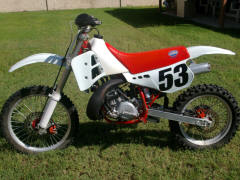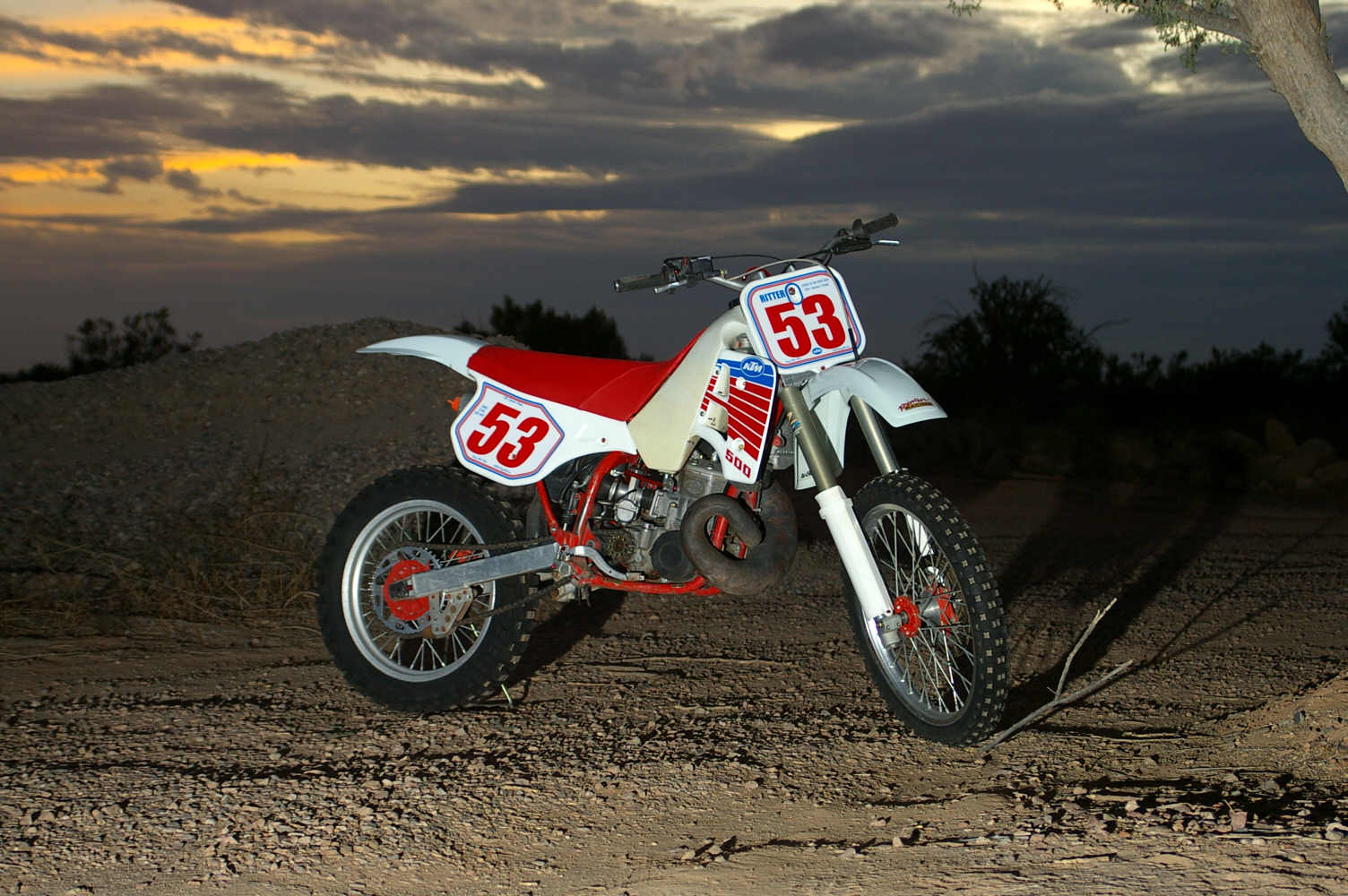
Lighten your MX Bike
How to take weight off a bike that has no frills!
My journey into the land of aluminum and titanium.
The starting point to the KTM project
My ride is a 1990 KTM 500 MXC. (Frita, short for Frita 32. My 32nd bike, one bike at a time, all Fritas.) Before I started the lightweight madness, it weighed 235 wet, no fuel. This means I drained the gas tank and the carb float bowl, then weighed it. It had Acerbis hand-guards, but otherwise basically just the bike. I actually started this whole project because I liked the look (and the price) of the anodized aluminum hardware available at Redmist Motorsports. I had gotten the thing mostly restored, to make a long story short I had to replace the motor and do a lot of sorting out. Two parts bikes helped a lot. So the lightening project started with a restored 500, all motor parts new, replica type graphics, suspension sorted out.
Heavy Frita, the start of the lightening project.
238 pounds wet, no fuel
Browsing the web, I came across Redmist Motorsports as a supplier of exotic hardware. The prices were very good, and the hardware looks cool. I noticed that for less money than a stainless bolt cost at the local Tru Value Hardware, I could get a red anodized aluminum part!
So here is the beginning. First order of yummy red aluminum hardware. On the left, all I purchased. In the middle, what was left over after the first pass at replacing stuff. On the right, the stuff I replaced with aluminum. So, I started with 4 ounces of aluminum, ended up with 2 ounces left over, and I replaced 9 ounces of steel hardware! Almost 1/2 pound saved right there. This ratio has been holding, as near as I can tell, so the aluminum weighs about a quarter of what the steel does. I have been using .3 to be on the conservative side. It's not what I read online, but it is what I'm measuring on my scales.
Location, location, location!
Where can you use aluminum in place of steel, and where would it be foolish to? These bolts are special heat treated aluminum, and if you look up the strength of the things it's about the same as steel. Plain, garden variety steel. Like the unrated stuff you get at the hardware store, the crap screws where the head strips out if you don't do everything right. The good fasteners you are replacing can be 3 or 4 times as strong. So where this is going is DON'T use aluminum on critical items. Brake mounts, engine mounts, stuff like that. It's your behind if it breaks, so use your head. A brilliant place to use aluminum is for number plate mounts. Save a bit of weight, look cool, risk nothing. Manifold screws, side case screws, brake reservoir mounts... that kind of stuff. As I got more familiar with my bike and the strengths and weaknesses of the aluminum, I found more places to use them.
On the left, stainless screws I was sealing some holes in my swingarm with.
On the right, their aluminum replacements. Perfect! No risk, looks cool! LOL
It's like a disease, though, as you go along you get worse and worse. I've been keeping all the take-offs in a cup. Only bolts that get replaced with an aluminum bolt go in the cup. It weighs 2 pounds, 2.8 ounces now! I actually stock quite a few sizes just in case I find a new location or break one off. I just got some grip-savers from Moose, they weighed 1.6 ounces for the pair. Of course, now they weigh 1.2 ounces; aluminum screw vs. steel one! Bwah-ha-ha-haaa!
The stockpile.
A good thing about aluminum is that it has a long elastic phase before it fails. I've tried aluminum in questionable places using some simple guidelines.
~NOTE: If you try to use aluminum somewhere and it breaks and you bust your behind, it's YOUR fault. I'm telling you that you should NOT do anything you read here. Or anywhere else, if you can't take responsibility for your own actions. Sorry, just had to say it!~
So I would see that the bolt could take the recommended torque for that position. Front axel clamps on my bike are torqued to 7 foot pounds. They are 6mm bolts. I took an extra bolt for destructive testing, and torqued it in steps until it broke. It took 10 foot pounds, but then it twisted and twisted and came off without making 11 foot pounds. Hmmm. Close. I installed them as axel clamps and rode one easy ride, then checked the torque. The theory is that if the bolt stretches plastically it'll require retorquing. An easy ride passed, torquing them to 7 pounds again produced no movement. Next, off to the MX track. I found that after every practice day at the track, I'd have to tighten them something like 1/8 turn. Out they came, and straight into the trash can. High grade steel is doing the job there at this point. I don't want to break anything, especially my behind!
Another questionable spot is on the triple clamps. They are 8mm bolts, and the lower clamps take 11 foot pounds, the uppers take 18. My test bolt broke off at 16 or 17, I don't remember now. Low enough the upper clamp was not an issue, but high enough the lower clamp was a possibility. Same rules as before, stuck 'em in the holes and go ride. These have never moved when I check the torque, so I'm very happy with them in that position. The upper holes are getting Titanium. 8^)
And now, headstay bolts?
My newest adventure is the headstay. I've installed them, we'll see how they hold up. I'm comfortable with this experiment because the headstay isn't a critical structural element; the bikes didn't have them in '88 in the same frame with the same motor. If they fail, I'll loose some stiffness from the frame, and that's all. They do look cool, though! There are several colors available, I'm using the red for obvious reasons.
Update: April 16, 2009
Headstay bolts: After the test ride, did take some additional torque. However, I didn't set them with a torque wrench so it's hard to say it I just added some or if they loosened. As non-criticals, I'm not going to worry about it. I'll check 'em after every ride and see how they do. May end up putting Ti in there, may get away with Aluminum. Time will tell!
Upgraded my scales:
When I started I just had the little spring scale in the pix above. Now...
These 2 beauties are telling me the weight details. It's so much nicer, having digital accuracy!
And the Scariest thing I've done yet: Handlebar clamp bolts!
First test ride is already in the books. I torqued them to 14 foot-pounds, and a torque check after the ride resulted in zero movement! I'd hate for these to let go, but the usual problem is that the bars twist in the clamps. I used to have to really crank down on the handlebar clamps bolts; but that was in the days of 7/8" bars. The fatty Magura bars have that gnarly finish that helps grip the clamps, and are 1 1/8" in the clamps so there is more grip surface and better leverage on the bar ends. No problemo!

That's my Girl! Frita 32, in all her glory.
Perfect reproduction graphics from Art at Privateer Racing.
226.2 pounds wet, no fuel. And there may be more to come off!